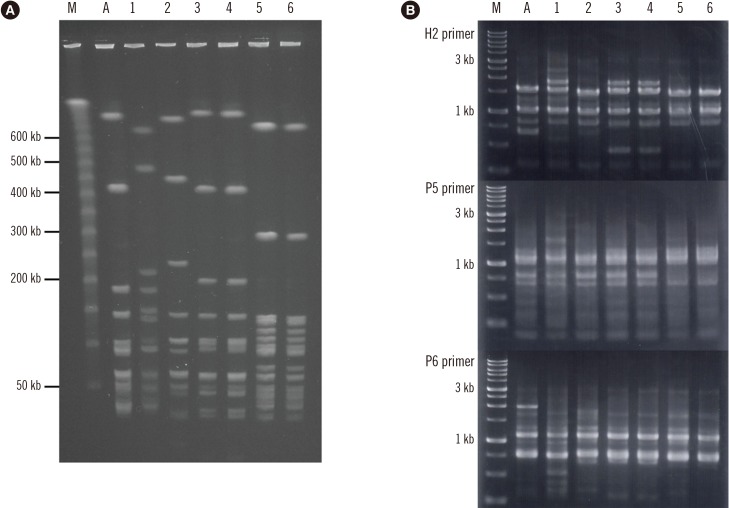Ann Lab Med.
2019 Sep;39(5):488-492. 10.3343/alm.2019.39.5.488.
Comparison of Characteristics of Streptococcus dysgalactiae subsp. equisimilis Isolates Causing Repetitive vs Single Infections
- Affiliations
-
- 1Department of Clinical Laboratory, Kitasato University Medical Center, Saitama, Japan.
- 2Laboratory of Infectious Diseases, Kitasato Institute for Life Sciences, Kitasato University, Tokyo, Japan. taka2si@lisci.kitasato-u.ac.jp
- 3Department of Health and Medical Sciences, Shinshu University Graduate School of Medicine, Nagano, Japan.
- KMID: 2450972
- DOI: http://doi.org/10.3343/alm.2019.39.5.488
Abstract
- No study has described Streptococcus dysgalactiae subsp. equisimilis (SDSE) isolates that cause repetitive infections (recurrence and reinfection). We compared the microbiological characteristics of SDSE causing repetitive infections with those causing single infections. Three patients with invasive infections were identified based on their medical records, and multiple SDSE isolates were collected at intervals over three weeks, using a laboratory repository. Isolates from 12 patients with single-episode infections served as controls. Six isolates were collected from three patients with first and second episodes of infection. All isolates causing either repetitive or single-episode infection were subjected to emm typing, multilocus sequence typing (MLST), pulsed-field gel electrophoresis (PFGE), and random amplified polymorphic DNA (RAPD) analyses. Amplification of five virulence genes (sicG, prtF1, prtF2, lmb, and cbp), biofilm formation (BF), and cell invasion abilities (CIAs) were measured as virulent phenotypes. We observed close genetic similarities in the data obtained by emm typing, MLST, PFGE, and RAPD in four isolates from two patients, suggesting recurrence, whereas two isolates from one patient indicated genetic differences in these data, suggesting re-infection. The presence of the five virulence genes and the BF and CIA measurements appeared not to contribute to repetitive infections, compared with isolates causing single-episode infection. In conclusion, clinicians encountering patients with repetitive infections should be aware of both possibilities: recurrence with closely related strains and reinfection with different strains.
MeSH Terms
Figure
Reference
-
1. Nielsen SV, Kolmos HJ. Bacteraemia due to different groups of beta-haemolytic streptococci: a two-year survey and presentation of a case of recurring infection due to eStreptococcus “quisimilis”. Infection. 1993; 21:358–361. PMID: 8132363.2. Liao CH, Liu LC, Huang YT, Teng LJ, Hsueh PR. Bacteremia caused by group G Streptococci, Taiwan. Emerg Infect Dis. 2008; 14:837–840. PMID: 18439377.3. Suzuki K, Nakamura A, Ishikura K, Imai H. Recurrent SDSE bacteraemia resulting in streptococcal toxic shock syndrome in a patient with Noonan syndrome. BMJ Case Rep. 2016; 2016:pii: bcr2016216092.4. Trell K, Sendi P, Rasmussen M. Recurrent bacteremia with Streptococcus dysgalactiae: a case-control study. Diagn Microbiol Infect Dis. 2016; 85:121–124. PMID: 26906192.5. Takahashi T, Sunaoshi K, Sunakawa K, Fujishima S, Watanabe H, Ubukata K, et al. Clinical aspects of invasive infections with Streptococcus dysgalactiae ssp. equisimilis in Japan: differences with respect to Streptococcus pyogenes and Streptococcus agalactiae infections. Clin Microbiol Infect. 2010; 16:1097–1103. PMID: 19732082.6. Fujita T, Horiuchi A, Ogawa M, Yoshida H, Hirose Y, Nagano N, et al. Genetic diversity in Streptococcus dysgalactiae subsp. equisimilis isolates from patients with invasive and noninvasive infections in a Japanese university hospital (2014-2015). Jpn J Infect Dis. 2017; 70:100–104. PMID: 27000456.7. Takahashi T, Fujita T, Shibayama A, Tsuyuki Y, Yoshida H. Prevalence of complement-mediated cell lysis-like gene (sicG) in Streptococcus dysgalactiae subsp. equisimilis isolates from Japan (2014–2016). Ann Lab Med. 2017; 37:297–304. PMID: 28445008.8. Kim S, Byun JH, Park H, Lee J, Lee HS, Yoshida H, et al. Molecular epidemiological features and antibiotic susceptibility patterns of Streptococcus dysgalactiae subsp. equisimilis isolates from Korea and Japan. Ann Lab Med. 2018; 38:212–219. PMID: 29401555.9. Ciszewski M, Szewczyk EM. Potential factors enabling human body colonization by animal Streptococcus dysgalactiae subsp. equisimilis strains. Curr Microbiol. 2017; 74:650–654. PMID: 28314902.10. Kawabata S, Kuwata H, Nakagawa I, Morimatsu S, Sano K, Hamada S. Capsular hyaluronic acid of Group A Streptococci hampers their invasion into human pharyngeal epithelial cells. Microb Pathog. 1999; 27:71–80. PMID: 10458918.11. CLSI. Performance standards for antimicrobial susceptibility testing: 22nd informational supplement. M100-S22. Wayne, PA: Clinical and Laboratory Standards Institute;2012.12. Lo HH, Cheng WS. Distribution of virulence factors and association with emm polymorphism or isolation site among beta-hemolytic group G Streptococcus dysgalactiae subspecies equisimilis. APMIS. 2015; 123:45–52. PMID: 25244428.13. Eriksson BK. Anal colonization of group G beta-hemolytic streptococci in relapsing erysipelas of the lower extremity. Clin Infect Dis. 1999; 29:1319–1320. PMID: 10524984.
- Full Text Links
- Actions
-
Cited
- CITED
-
- Close
- Share
- Similar articles
-
- A Case of Neonatal Meningitis Caused by Streptococcus dysgalactiae subspecies dysgalactiae and Herpes Simplex Virus
- Pathologic and molecular characterization of Streptococcus dysgalactiae subsp. equisimilis infection in neonatal piglets
- Detection of Streptococcus dysgalactiae subsp. equisimilis in equine nasopharyngeal swabs by PCR
- Molecular Epidemiological Features and Antibiotic Susceptibility Patterns of Streptococcus dysgalactiae subsp. equisimilis Isolates from Korea and Japan
- Identification of streptococcus dysgalactiae subsp. equisimilis from septic knee by 16S rRNA gene sequencing


